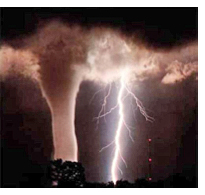
National Preparedness Month: Pledge to prepare
“By failing to prepare, you are preparing to fail.” - Benjamin FranklinAda City-County Emergency Management
2011 was a historic year for natural disasters nationwide. Twelve different weather-related disasters in the United States caused more than $1 billion in damage each. This broke the record of nine $1 billion disasters set in 2008, according to the National Oceanic and Atmospheric Administration (NOAA).
Combined, the damage from the 2011 events exceeded $50 billion.
 "In many ways, 2011 rewrote the record books. From crippling snowstorms to the second-deadliest tornado year on record to epic floods, drought and heat, and the third-busiest hurricane season on record, we've witnessed the extreme of nearly every weather category," said NOAA spokesman Christopher Vaccaro.
"In many ways, 2011 rewrote the record books. From crippling snowstorms to the second-deadliest tornado year on record to epic floods, drought and heat, and the third-busiest hurricane season on record, we've witnessed the extreme of nearly every weather category," said NOAA spokesman Christopher Vaccaro.
Last spring, the Boise River flowed at or above flood stage for weeks and created the need for flood response efforts by local agencies. Now, firefighters from all over the U.S. are in Idaho battling close to 50 different wildfires.
These fires have caused evacuations and road closures. Disasters and even near-disasters force people to evacuate, sandbag or take other emergency actions. Being ready to make good decisions during an emergency requires planning and preparation.
September is National Preparedness Month; the theme for 2012 is “Pledge to Prepare.” Disasters happen; don’t be caught unaware; now is the time to prepare.
Approximately 95 percent of the homes in the United States have insurance. Insurance is a form of financial preparedness that protects the owner from a future, possible event. A recent poll states that only 22 percent of households felt fully prepared for a disaster. Disasters are that future possible event. Today is the day to take the three basic steps towards preparedness.
1) Be informed
2) Make a plan
3) Build a kit
It is hard to get motivated to take on a project without knowing why. Creating a plan and gathering supplies for a kit requires time and money. Here is a link to answer “why?” with information about possible local hazards: http://www.accem.org/hazards.html
Being informed about not only what can happen but the potential effects that could happen is the first step in being prepared. This information helps create plans and kits that address the aftermath of the disasters that can occur.
Approximately 95% of the homes in the United States have insurance. Insurance is a form of financial preparedness that protects the owner from a future, possible event. A recent poll states that only 22% of households felt fully prepared for a disaster. Disasters are that future possible event. Today is the day to take the three basic steps towards preparedness.
Get help creating a plan and a kit
As the most comprehensive guide to personal emergency preparedness published by the Federal Emergency Management Agency (FEMA) "Are You Ready?" brings together facts on disasters and disaster survival techniques, and how to prepare for and respond to both natural and man-made disasters.
This booklet provides a step-by-step outline on how to prepare a disaster supply kit, emergency planning for people with disabilities, how to locate and evacuate to a shelter, and even contingency planning for family pets.
To get your free copy of "Are You Ready? A Guide to Citizen Preparedness" from the FEMA Publications Warehouse call: (800) 480-2520
Putting all this together can seem like a daunting task. British author and historian James Howell once said, “All we can do is be better prepared today than yesterday and better prepared tomorrow than today.” Whether just starting or expanding, take whatever step you need to raise your level of preparedness for tomorrow.
Published 8-31-2012